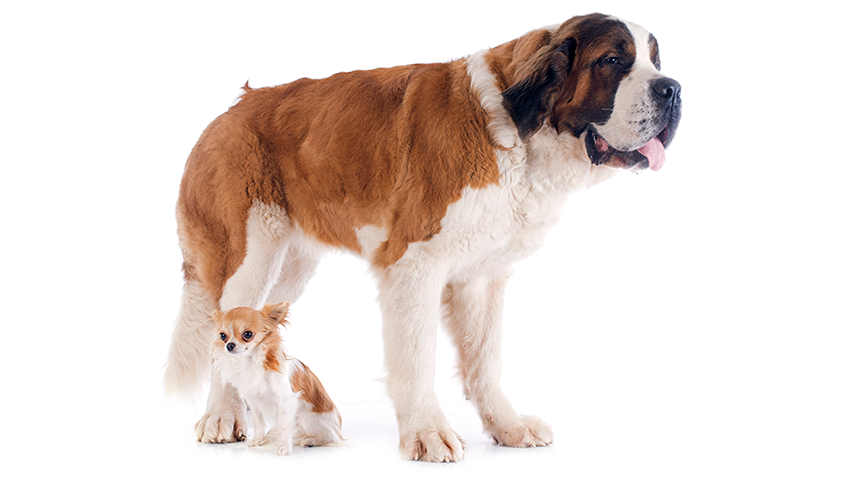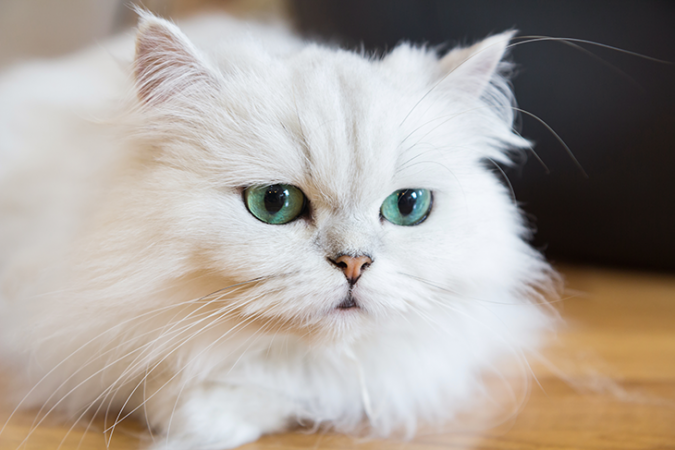DNA testing looks into dog breeds and cat history
Genetic tweaks can result in pets that belong to the same species but look very different

A chihuahua and a St. Bernard don’t look like they have much in common. But they’re both the same sub-species. What’s the difference? A few genes.
cynoclub/iStock/Getty Images Plus
St. Bernards are tall, hairy, muscular dogs, built for a life rescuing trapped travelers in the mountains of Europe. Chihuahuas are tiny, with shorter hair and rounder heads. They come from Mexico. Looking at them side by side, you might be tempted to question whether they’re the same species. Yet for all their dramatic differences, each can still mate with any other dog and produce pups. That’s because a big boy St. Bernard and an itsy bitsy chihuahua are the same subspecies — Canis lupus familiaris.
The differences in the appearances of these two dog breeds trace to tiny variations in their DNA. DNA is a long string of smaller molecules called nucleotides (NU-klee-oh-tydz). They come in four types — adenine (A), cytosine (C), thymine (T) and guanine (G). The order in which those four letters occur spells out the instructions that tell each cell what molecules to make. And those DNA strings are highly specific to each individual.
One may have a string of letters that are almost identical to another’s. But the first may have a C at a site where the other has a T. That single difference might change what molecule is made from that long sequence of letters — giving one dog curly fur instead of straight, or short limbs instead of long.
Each parent passes along half of its DNA to its puppy. That DNA codes for traits that will collect over doggie generations. Eventually, if breeders select for certain traits (mating dogs with the same chosen traits over and over), they can create a new breed.
A couple of tweaks here might produce the long floppy ears characteristic of a basset hound. Another few tweaks over there might produce the short stumpy legs and elongated snout of a dachshund. Still more tweaks might make no changes at all.
Scientists refer to these small but important tweaks as SNPs (pronounced snips). That’s short for single nucleotide polymorphisms (Pah-lee-MOR-fizms). SNPs are places where one nucleotide has randomly substituted for another — where a G, for example, might have taken the place of a T. Millions of SNPs appear within the DNA of every dog (and cat, and human). Comparing patterns of SNPs in dogs that look alike or have other characteristic traits can help scientists find what subtly sets each breed apart.
By searching for those SNP patterns, scientists can later figure out from which breeds a dog or cat has descended.
Hunting down dog SNPs
To make that work, scientists first need to identify those patterns. Scientists like Angela Hughes. She’s an animal geneticist at Mars Petcare (yes, the Mars that makes M&Ms) in Vancouver, Wash. Hughes heads a team that makes Wisdom Panel. It’s a test to find out what breeds are in a dog’s ancestry.
To figure out which SNP patterns define a breed, Hughes needs dogs. Her own mutt — a mix of an Australian cattle dog and a Jack Russell terrier — won’t cut it. She needs dogs that people have been specifically breeding for generations. “We go out and work with breeders and [dog] shows,” she says. “Sometimes we have to go out and find the breeders,” she says, because “they don’t always come to shows.”
Her team tries to test several hundred dogs of each breed. They also get different types of the same breed — such as retrievers that have been bred for hunting and retrievers that have been bred to be show dogs or pets.
Then, when someone sends in a sample from their pet to Wisdom Panel, scientists can look for distinctive SNPs in its DNA. To identify a dog’s lineage, they plug in 1,800 gene sequences, each with its own SNP. Then they’ll compare these to those in the pet.
A computer program then uses an algorithm (AL-go-RITH-um) to find the best match between this pet and the known SNPs of purebred breeds. “If the dog could be only one thing, which of these would it best match?” Hughes asks. “And if it were two things, what would be the best match?” The program does this all the way to figure out a dog’s great-grandparents.
Wanted: Millions of mutts
There are several other tests for a dog’s DNA. Adam Boyko founded the company EmBark to make one of them. Boyko is a geneticist at Cornell University in Ithaca, N.Y. He developed the test to get more data for research. Most of his tests, though, start not with EmBark clients but with his dog, Penny — a mix of Jack Russell terrier, Pomeranian and miniature pinscher. “When she sees a swab, she jumps up. She knows there will be a treat,” he says. “We test a lot of prototypes on her.” But while Penny is a great experimental subject, she’s only one dog.
“There’s a billion dogs in the world, and most are not purebred,” he notes. “If you want to make discoveries about what makes unique behavior in dogs, what underlies cancer risk or risk of … allergies, you need way bigger sample sizes,” he says. He figured he could only get enough samples if he created a test that anyone might use on their pets.
His computer program works a bit differently than a SNP test. It looks at more than 200,000 different genetic fingerprints. These are patterns of DNA changes that sit close to each other on chromosomes.
Chromosomes are long, tightly coiled pieces of DNA. When animals mate, their DNA mixes. In the process, chunks of their chromosomes tend to end up close to each other. Scientists can trace those chromosome chunks back to the parent who passed them on, Boyko explains. EmBark then compares the DNA in those chromosome chunks to the DNA in known dog breeds
Boyko can identify a dog’s ancestral breeds. He can even find that dog’s closest puppy cousins. That’s important, he notes, for people who breed purebred dogs. Many of these dogs have been inbred — bred with animals to which they are too closely related. That can be bad for the health of their puppies. By finding their close relatives, Boyko can help people breed healthier dogs.

Here kitty, kitty
“There’s more researchers in dogs than there are in cats,” observes Robert Grahn. Still, he points out, cats can get their DNA tested, too.
Grahn, a geneticist at the University of California, Davis, notes that there are fewer cat breeds. Moreover, he notes, most cats aren’t really one “breed” or another. They’re just, well, cats. Most cats meet on the street and mate randomly, he explains. Those are the “domestic short hair” or “domestic long hair” cats that come in black, white, tabby, calico and more. Persians, Siamese and other cat breeds are purebreds. They are often bred to compete in shows. But owners tend to keep these expensive cats to themselves, Grahn says. They “tend to stay inside. How many times have you seen a Persian wandering the street? You don’t let that out.” (Though he studies cats, Grahn himself is more of a dog person. “I had the best cat ever,” he explains. But once that cat died, “any other cat I would have wouldn’t measure up.” Now he has a Labrador named River.)
People who breed cats may still want to know about their pet’s family tree. A genetic test such as Basepaws can detect cat breeds. The test hunts for SNPs just as the dog tests do. But instead of trying to get a saliva sample from an indignant feline, a chunk of cat hair will do.
Such a test can tell you about possible coat colors and fur length. But with so many “domestic short hair cats” in the world — such as the many random tabbies and tuxedos — knowing their ancestral breed might not be as interesting as learning where in the world its ancestors came from. That’s why Leslie Lyons helped develop the Cat Ancestry test at UC Davis. It shows the part of the world where your cat’s ancestors might have developed.
Lyons is a geneticist. She works at the University of Missouri in Columbia where she and her laboratory have built a genetic library for cats. “I think they’re the perfect little species,” she says. She wouldn’t say she owns cats, herself. “Four cats share my home,” she explains. “I live in a rural area,” and so the cats come and go as they please.
Domestic cats, notes Lyons, are not native to North America. “They’re imports.” They came from Europe, southeast Asia — maybe even the Mediterranean, she says. The Cat Ancestry test identifies patterns of SNPs from these areas. Then it compares them to the SNPs in your cat. So sure, yours might be another domestic short hair. But it may turn out to have a Western European heritage, or an Asian one. Wouldn’t you like to know which?







